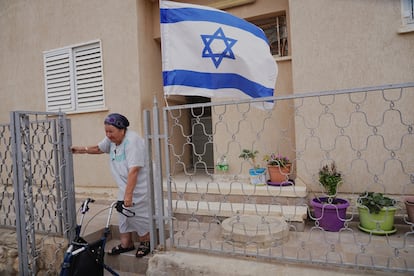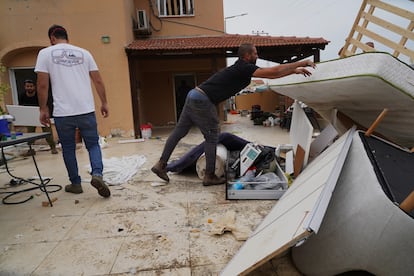Ofakim: An Israeli town tries to go back to normal after Hamas killed 53 residents
The streets of the furthest municipality that the Gaza-based Islamist militia attacked on October 7 is gradually recovering activity amid tributes to the victims

“Fuck you, Palestine.” The graffiti shows up on several walls in the Mishor Hagefen neighborhood of Ofakim, 22 days after Hamas killed 53 residents in this town of about 30,000. Hatred and indignation remain strong, and activity in the streets remains slow despite the fact that the Israeli government did not order an evacuation, like it did in other locations. “We need more weapons, more security,” complains Nadav Wakni, 22, an employee at a Mexican fast food restaurant who claims he narrowly escaped getting shot. His request is supported by several of his neighbors. A few feet from the spot where the young man shows the bullet impacts, on the wall of a house, a small altar has been created with candles, a police cap, a stuffed animal and a photograph of officer Ronnie Abohern, one of those who gave his life defending the city.
In the sky, the planes that incessantly bomb the neighboring Gaza Strip fly overhead and are constantly visible, and the airstrikes at times become Ofakim’s soundtrack. The town, located in southern Israel, is 15.5 miles (25 km) in a straight line from the Palestinian enclave, where more than 8,000 people have already died in retaliation for the Hamas attack, according to Gaza authorities. Ofakim is the furthest point of the 30 locations where the Islamist fundamentalists struck on October 7 with a death toll of 1,400 and over 200 hostages, according to Israeli authorities.
Ofakim is slowly waking up from the nightmare, because for many, what happened that day continues to play out like “a movie,” says Patricia Caro, a 66-year-old born in Argentina who moved to Israel 33 years ago. Caro went back to her job at an electronic components factory a few days ago. “At first we didn’t know if they were kids playing in the street, then we realized they were terrorists,” she recalls.
The young Nadav Wakni talks about the years he spent in Los Angeles. “If this were the United States, we would have all kinds of weapons now,” he says. He lives in a three-story block whose walls are spray-painted in favor of Israel and against “terrorists.” The house directly opposite is that of the couple formed by Rachel and David Edry. Dozens of gunshot marks testify to the battle that was fought in the house, where five Hamas members barricaded themselves inside with the couple for 15 hours. The place is a coming and going of neighbors who stop to talk, turning it into something of a place of pilgrimage.

Considered a national hero, Rachel managed to entertain the militiamen with cookies, conversation and songs and stay alive until several police officers and armed civilians came to rescue them. Miraculously, the five attackers were killed and the couple were rescued alive. One of those who died in that operation was officer Ronnie Abohern. On Sunday, several people were taking out furniture and all kinds of belongings; they even tore out the window frames in an attempt to erase the memories of that unfortunate day from the house itself.
The streets of Mishor Hagefen neighborhood are dotted with canvases depicting the faces of the fallen. There are also traces of blood on the door of the shelters where the attackers finished off some of the residents who were trying to get to safety. Liran Pérez, a 38-year-old engineer, is one of the more than 300,000 reservists who were called up after October 7. He is deployed in Ofakim along with other soldiers. A son of Moroccan immigrants who “arrived in the 1960s to the promised land to make a new life for themselves,” Pérez understands that in the city “there will not be normal life for months.” “These neighbors across the street left us the keys before they left in case we needed to go into the house to take a shower,” he says, surrounded by some of his colleagues.
Indeed, the pace of life is recovering in fits and starts, with small businesses, companies and factories that make essential products reopening little by little. Public transportation is also operating, but schools remain closed, although activities are being organized for children, explained a municipal spokesperson. This is not the case in Sderot, a city located less than a mile from Gaza and which has been evacuated, or in the kibbutzim that surround Gaza, which were severely hit and are today a closed military zone from where the army has undertaken the ground invasion. These agricultural communities, where destruction reigns and the trail of death is still present, cannot even bury their dead. At the moment, for security reasons, they are doing so provisionally in cemeteries far from the Palestinian enclave.

As a healing therapy, the Ofakim City Council offers residents the possibility of staying a week in a hotel far from their homes. Some 10,000 people have already taken advantage of this program, according to municipal sources. Rachel Marciano, 85 years old and mother of 10 children born between her native Morocco and Israel, is one of those who refuses to go anywhere, even though she lives alone. This woman, who arrived in Israel in 1963 from Tétouan with her husband “when there was nothing in Ofakim,” moves slowly down the street leaning on her walker under the passing planes. The sound of the airstrikes from the attacks in Gaza no longer overwhelm her after three weeks. “I’m not scared, although sometimes they get to your heart,” she says, letting her hand slide down his chest.
Her eyes fill with tears as she remembers October 7, when she did not leave her house, located about 900 feet from where Hamas members killed dozens of her neighbors. “They killed a lot of people. Some children were cut into pieces. Oh, what a shame,” she says, speaking to the reporter in perfect Spanish inherited from the years when parts of northern Morocco were a Spanish protectorate. “The Moors are very bad.”
Sign up for our weekly newsletter to get more English-language news coverage from EL PAÍS USA Edition
Tu suscripción se está usando en otro dispositivo
¿Quieres añadir otro usuario a tu suscripción?
Si continúas leyendo en este dispositivo, no se podrá leer en el otro.
FlechaTu suscripción se está usando en otro dispositivo y solo puedes acceder a EL PAÍS desde un dispositivo a la vez.
Si quieres compartir tu cuenta, cambia tu suscripción a la modalidad Premium, así podrás añadir otro usuario. Cada uno accederá con su propia cuenta de email, lo que os permitirá personalizar vuestra experiencia en EL PAÍS.
¿Tienes una suscripción de empresa? Accede aquí para contratar más cuentas.
En el caso de no saber quién está usando tu cuenta, te recomendamos cambiar tu contraseña aquí.
Si decides continuar compartiendo tu cuenta, este mensaje se mostrará en tu dispositivo y en el de la otra persona que está usando tu cuenta de forma indefinida, afectando a tu experiencia de lectura. Puedes consultar aquí los términos y condiciones de la suscripción digital.
More information
Archived In
Últimas noticias
Maduro pleads not guilty before the federal court in New York: ‘I am still the president of Venezuela’
A new test can detect Alzheimer’s from a finger prick
UN team enters Sudanese city of El Fasher after paramilitary massacre: ‘It’s like a ghost town’
A recipe for resistance: Indigenous peoples politicize their struggles from the kitchen
Most viewed
- Gilles Lipovetsky: ‘If you want to live better and fall in love, take Prozac, don’t look to philosophy’
- Alain Aspect, Nobel laureate in physics: ‘Einstein was so smart that he would have had to recognize quantum entanglement’
- Alvin Hellerstein, a 92-year-old judge appointed by Bill Clinton, to preside over Maduro’s trial in New York
- Why oil has been at the center of Venezuela-US conflicts for decades
- Maduro’s downfall puts China’s relationship with Venezuela to the test











































